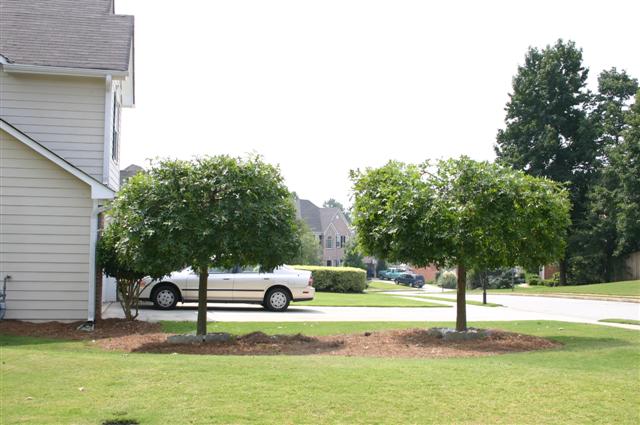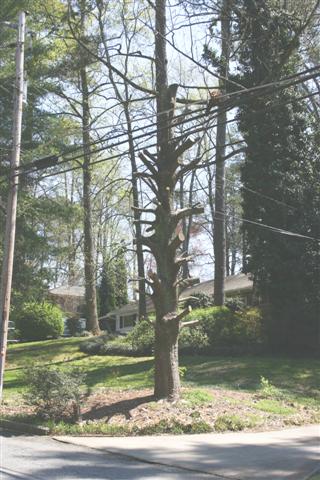Georgia Gardener Newsletter Design Tip: December 27, 2007
This was a Southern Magnolia, now it's a totem pole.
Plants have been in existence for millions of years and man has been around for less than 100,000 years. Prior to our arrival
and the domestication of plants, pruning was never done. Therefore, pruning is a human activity done primarily for our needs and
not necessarily for those of the plant. I envision the first
active pruning being that of a caveman pulling a dead limb from a tree for fire wood. For the most part, plants don't need
pruning. They can shed problem parts very well on their own. However, since the questions surrounding pruning can be challenging
and usually make up nearly half of the questions sent to us, I will cover the basics here by plant group: herbaceous (perennials
and annuals), shrubs, trees and conifers as a separate group.
There are dozens of web sites and books dedicated to proper practices of pruning. In order to keep this article in check, links
will be provided where necessary.
Basic Guidelines
There are two guidelines that supersede the more specific guidelines below.
First, always use the correct tool for the job: hand pruners, loppers, pole saw, hand saw or chainsaw. Make sure the tool is sharp,
in proper working condition and that you know how to correctly use it.
Second, you can prune at any time of year those parts of a plant that I call the four D's: Dead, Dying, Diseased or Damaged.
Pruning Herbaceous Plants
Herbaceous plants are usually perennials or annuals in that they will either die back to the roots or completely die at the
end of the growing season. Pruning on these is often labelled as follows:
Deadheading: removing spent flowers to eliminate seed production and/or encourage additional blooms
Pinching: cutting back the plant to encourage thicker growth
Tidying: removing unsightly foliage and/or shaping
Clearing: removing the top growth after frost (perennials) or removing the dead plant (annuals)
Herbaceous plants produce blooms on the current season's growth, so pruning can be done either at the end of the previous season, or
as new growth appears early in the season or as needed during the growing season.
Pruning Shrubs
The pruning of shrubs can be a bit more tricky and therefore, I divide shrubs into broadleaf evergreens
(excluding conifers) and flowering. Of course, there is overlap in these two groups.
How Much?
Healthy shrubs can often take a severe pruning, if it isn't done too frequently. In fact, some shrubs benefit from a "rejuvenation"
pruning done every few years if they become leggy or misshapened. I find this works well on broadleaf evergreens such as boxwoods, hollies,
loropetalums and even azaleas. Other than that, it's advisable to not remove more than 25% of
the total plant in a single pruning.
When?
For broadleaf evergreen plants whose sole purpose in the garden is the foliage (screening, etc.), most pruning should be done in
the late winter (mid/late February for northern Georgia). The plants will leaf out shortly as spring approaches. A dose of fertilizer
would be of benefit at this time, also.
The pruning of flowering shrubs is a bit more problematic. Blooming shrubs produce flowers either on the current season's growth
(shrub roses, gardenias, crape myrtles, and some hydrangeas, etc.) or on the previous season's growth (azaleas, climbing roses,
camellias, forsythia, and other hydrangeas, etc.). If you prune at the wrong time, you can either delay or destroy the next
season's blooming cycle. As a general rule, if a shrub blooms before June 1, it more than likely blooms on the previous season's
growth. After June 1 is a good indicator of blooming on the current season's growth but there can be some exceptions.
When in doubt, prune just as the bloom is finishing.
Below are links that contain pruning tips for some of our more common shrubs:
Shrub Roses
Climbing/Rambling Roses
Crape Myrtles
Hollies, Boxwoods & Gardenias
Hydrangeas
Azaleas & Rhododendrons
Loropetalums
Camellias
...and some
additional information
Pruning Trees
As a Certified Arborist, nothing bothers me more than the improper pruning of trees. Since tree growth differs from
shrubs (leaders, branches, etc.) and their growth rate is often slower, improper pruning of trees can permanently destroy
the growth habit and lead to a weakened plant.
Once again there are several general rules that I apply to the pruning of trees:
1. Leave the pruning of large or high limbs to the professional companies with Certified Arborists on staff.
2. Never put anything on the pruning cuts. It only hinders the tree's ability to seal off the injury.
3. Never, ever top a tree. Any company that tops trees is unprofessional and engaged in a substandard practice.

These pin oaks were topped and will never grow correctly again
How Much?
Once again, it's advisable to not prune more than 25% of a tree's canopy in a single pruning.
When?
For flowering trees as with shrubs, blooms are either produced on the previous or current season's growth and generally follow
the same June 1 differentiation. However for most deciduous trees (flowering or not), pruning is best done in the winter (January) when
the leaves are down and the architecture is easily seen. Just remember that with flowering trees such as cherries, redbuds
and dogwoods, winter pruning will be removing some flower buds.
Tree Pruning Links:
Pruning Landscape Trees
Pruning Shade Trees
Pruning Conifers (Needled Evergreens)
Whether they are trees or shrubs, I usually place my conifers in locations where pruning will not be necessary. Conifers are
often slower growing and differ in their ability to regenerate after pruning. Some, such as yews, will sprout new growth
near the pruning site. Many others, such as pines, arborvitaes and junipers lack dormant buds and
won't germinate new growth on old branches or if pruned back beyond the needles. Conifers should never be severely pruned.
Pruning Conifers (General)
Professional Help
Should you decide to call in some professional help, you can always get assistance from tree companies listed on the web site of the
Georgia Arborist Association. One of the
most talented professional pruners I know is Rick Smith: The Pruning Guru who
can be contacted through his web site.
Copyright © 2007 by Theresa Schrum - All rights reserved
No part of this website may be reproduced without the expressed written permission of Theresa Schrum


